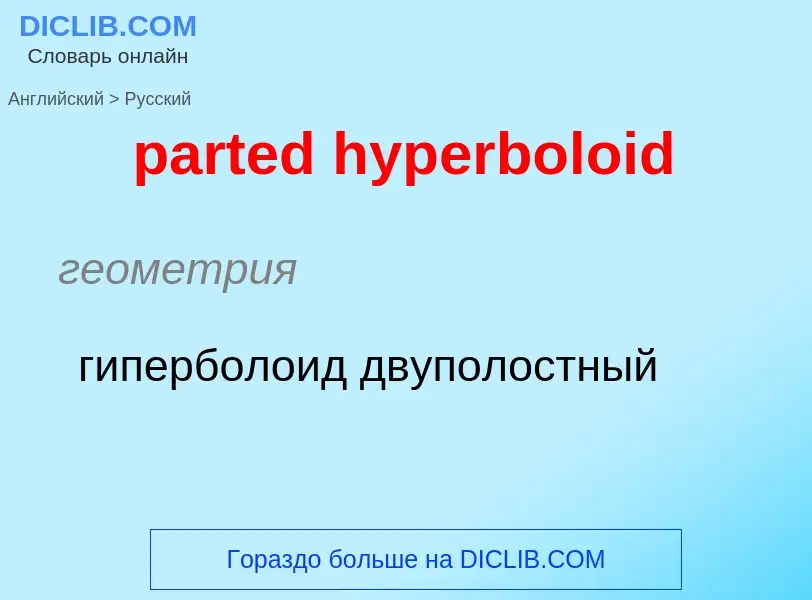Translation and analysis of words by ChatGPT artificial intelligence
On this page you can get a detailed analysis of a word or phrase, produced by the best artificial intelligence technology to date:
- how the word is used
- frequency of use
- it is used more often in oral or written speech
- word translation options
- usage examples (several phrases with translation)
- etymology
parted hyperboloid - translation to russian
геометрия
гиперболоид двуполостный
математика
двухполостный гиперболоид
математика
однополостный гиперболоид
Definition
Wikipedia

In geometry, a hyperboloid of revolution, sometimes called a circular hyperboloid, is the surface generated by rotating a hyperbola around one of its principal axes. A hyperboloid is the surface obtained from a hyperboloid of revolution by deforming it by means of directional scalings, or more generally, of an affine transformation.
A hyperboloid is a quadric surface, that is, a surface defined as the zero set of a polynomial of degree two in three variables. Among quadric surfaces, a hyperboloid is characterized by not being a cone or a cylinder, having a center of symmetry, and intersecting many planes into hyperbolas. A hyperboloid has three pairwise perpendicular axes of symmetry, and three pairwise perpendicular planes of symmetry.
Given a hyperboloid, one can choose a Cartesian coordinate system such that the hyperboloid is defined by one of the following equations:
or
The coordinate axes are axes of symmetry of the hyperboloid and the origin is the center of symmetry of the hyperboloid. In any case, the hyperboloid is asymptotic to the cone of the equations:
One has a hyperboloid of revolution if and only if Otherwise, the axes are uniquely defined (up to the exchange of the x-axis and the y-axis).
There are two kinds of hyperboloids. In the first case (+1 in the right-hand side of the equation): a one-sheet hyperboloid, also called a hyperbolic hyperboloid. It is a connected surface, which has a negative Gaussian curvature at every point. This implies near every point the intersection of the hyperboloid and its tangent plane at the point consists of two branches of curve that have distinct tangents at the point. In the case of the one-sheet hyperboloid, these branches of curves are lines and thus the one-sheet hyperboloid is a doubly ruled surface.
In the second case (−1 in the right-hand side of the equation): a two-sheet hyperboloid, also called an elliptic hyperboloid. The surface has two connected components and a positive Gaussian curvature at every point. The surface is convex in the sense that the tangent plane at every point intersects the surface only in this point.





![The [[Adziogol Lighthouse]], [[Ukraine]], 1911. The [[Adziogol Lighthouse]], [[Ukraine]], 1911.](https://commons.wikimedia.org/wiki/Special:FilePath/ Adziogol hyperboloid Lighthouse by Vladimir Shukhov 1911.jpg?width=200)
![[[Kobe Port Tower]], [[Japan]], 1963. [[Kobe Port Tower]], [[Japan]], 1963.](https://commons.wikimedia.org/wiki/Special:FilePath/ Kobe port tower11s3200.jpg?width=200)
![[[Saint Louis Science Center]]'s James S. [[McDonnell Planetarium]], [[St. Louis]], [[Missouri]], 1963. [[Saint Louis Science Center]]'s James S. [[McDonnell Planetarium]], [[St. Louis]], [[Missouri]], 1963.](https://commons.wikimedia.org/wiki/Special:FilePath/ Mcdonnell planetarium slsc.jpg?width=200)
![[[Newcastle International Airport]] control tower, [[Newcastle upon Tyne]], [[England]], 1967. [[Newcastle International Airport]] control tower, [[Newcastle upon Tyne]], [[England]], 1967.](https://commons.wikimedia.org/wiki/Special:FilePath/ Newcastle International Airport Control Tower.jpg?width=200)
![[[Cathedral of Brasília]], [[Brazil]], 1970. [[Cathedral of Brasília]], [[Brazil]], 1970.](https://commons.wikimedia.org/wiki/Special:FilePath/ Catedral1 Rodrigo Marfan.jpg?width=200)
![toroidal]] tank, [[Ciechanów]], [[Poland]], 1972. toroidal]] tank, [[Ciechanów]], [[Poland]], 1972.](https://commons.wikimedia.org/wiki/Special:FilePath/ Ciechanow_water_tower.jpg?width=200)
![[[Roy Thomson Hall]], [[Toronto]], [[Canada]], 1982. [[Roy Thomson Hall]], [[Toronto]], [[Canada]], 1982.](https://commons.wikimedia.org/wiki/Special:FilePath/ Toronto - ON - Roy Thomson Hall.jpg?width=200)
![thorium]] [[nuclear reactor]] in [[Hamm]]-Uentrop, [[Germany]], 1983. thorium]] [[nuclear reactor]] in [[Hamm]]-Uentrop, [[Germany]], 1983.](https://commons.wikimedia.org/wiki/Special:FilePath/ Thtr300 kuehlturm.jpg?width=200)
![The [[Corporation Street Bridge]], [[Manchester]], [[England]], 1999. The [[Corporation Street Bridge]], [[Manchester]], [[England]], 1999.](https://commons.wikimedia.org/wiki/Special:FilePath/ Bridge over Corporation Street - geograph.org.uk - 809089.jpg?width=200)
![Killesberg]] observation tower, [[Stuttgart]], [[Germany]], 2001. Killesberg]] observation tower, [[Stuttgart]], [[Germany]], 2001.](https://commons.wikimedia.org/wiki/Special:FilePath/ Killesberg Tower.jpg?width=200)
![The [[Canton Tower]], [[China]], 2010. The [[Canton Tower]], [[China]], 2010.](https://commons.wikimedia.org/wiki/Special:FilePath/ Canton tower in asian games opening ceremony.jpg?width=200)
